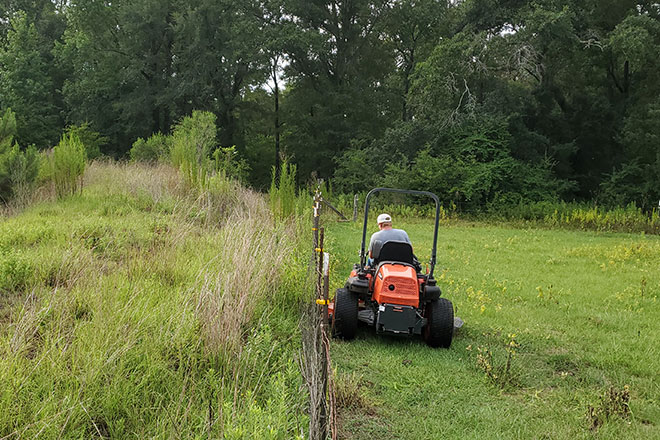Staff Photo
Why “neat and tidy” mowing is bad for quail
By Dr. James A. Martin
I spent a great deal of my youth working on a tobacco farm. Midway through every summer, right before it was time to start harvesting the crop (“pulling bacca” for you fellow North Carolinians), I was tasked with mowing the end of the rows to make it easier to walk around the field edges. It also helped show off the fields visible from the road—always a local competition in Woodsdale. Before we hit the big time, I did this with a John Deere 830 pulling a 6 ft wide Bush Hog rotary cutter. We of course called it a “bush hog” but there are many colloquial names for this implement. I’ve heard it called a clipper, cutter, mowing machine, brush hog, and — when the bearings on the PTO need replacing — it goes by names I shouldn’t repeat.
My grandfather started farming two generations before I did, and they never used such a contraption. Mule-drawn sickle mowers were used for cutting hay, not field edges. Expending the mule’s energy and your own for mostly aesthetic reasons was unheard of. Now contrast that with today’s practices, where 42-foot batwing mowers pulled by big cab tractors are a common sight.
The increasing availability of mowing equipment is unparalleled and has been driven by our increasing desire to keep things “clean” around field edges and roads. Of course, this does have some practicality, and perhaps even taps into our primordial evolutionary instincts to reduce predation risk by increasing our ability to detect predators, or to keep things like snakes and ticks at bay like. But mostly, it’s because we have fallen in love with neat and tidy. Peer pressure from our neighbors motivates us to mow our yards frequently, mow the edges around our bean fields, and mow the roadsides out to the highway. This isn’t doing our favorite gamebird any favors.
Bobwhites nest in herbaceous vegetation like clumps of grass that are ideally greater than 18 inches tall. Depending on your geography, they nest as early as May and wrap up nesting in September. In southern latitudes, flightless chicks can be seen as late as late October.
 Photo by Jess McGuire
Photo by Jess McGuire
Nothing in the bobwhite’s evolutionary history prepared them for a 30-ft batwing rolling behind a 150-horse tractor while the driver listens to the newest Tyler Childers song. Mowing over nests and young broods can be avoided by waiting after the first frost. Even then use the mower sparingly because overwinter cover is important too.
Mowing, if done appropriately, can be a useful management practice. Context matters, however. Post-burn mowing in areas with pesky hardwood saplings can reduce competition for the herbaceous plants we want for bobwhites. Post-burn mowing is best done after the first heavy rain immediately following a prescribed burn. The rain helps reduce the soot that gets into your tractor and mowing the hardwood saplings not top-killed by fire will give the herbaceous plants a leg up and increase the chances they will be killed by the next fire. Plus, because the area is still “black” from burning, little bobwhite cover is being removed.
Mowing hunting paths for hunters and dogs is a common practice on quail estates in the Southeast. The cover is often dense and full of briars so mowing narrow paths increases the number of covey-finds and makes for a much more enjoyable experience. These mowed paths only represent a very small percentage of the available cover for bobwhites so the tradeoff in reducing some cover but increasing hunting quality is a no-brainer.
For most situations, however, leave the tractor in the shed. If you can’t resist the urge to burn some diesel, only mow the width of a vehicle for two-track roads and a few feet around your sweet corn patch. Because when it comes to helping bobwhites during nesting season, the best place for your tractor and brush hog (or whatever you choose to call it) is the barn.